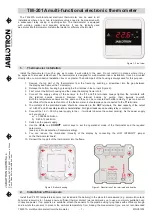
have different functions. One module may measure platinum resistance ther-
mometers (PRTs) while another may measure thermocouples. Still another
module may provide an interface to a printer. Modules may have more than one
independent function or
device
. For example, a single module may include a
GPIB communications device and a Centronics printer interface device. A sin-
gle device, such as a thermocouple scanner, may also contain multiple chan-
nels. By adding certain modules together, an instrument can be assembled with
extraordinary capabilities.
Every add-on module conforms to specific physical and electrical requirements.
This allows any module to be easily connected to the system. Up to eight mod-
ules can be stacked onto the base. Modules can be purchased at any time and
installed quickly and easily in the field allowing the system to grow as needs
arise. The base controller automatically recognizes attached modules. New
channels and functions immediately become available.
Each add-on module is an independent intelligent instrument. Modules contain
their own microcontroller, memory, and analog-to-digital converter, if neces-
sary. Communication between modules and the base uses a proprietary
high-speed digital bus. Modules are calibrated individually with calibration pa-
rameters stored in non-volatile memory within the module.
The physical layout of the 1560
Black Stack
is optimized for user convenience.
The front panel is tilted for clear viewing of the display and easy access to the
buttons. Measurements are displayed with large easy-to-read numbers. Bright-
ness and contrast of the screen are adjustable. The graphics LCD display is able
to show a large amount of information and can be configured for different uses.
In its statistical window mode, the display can simultaneously show measure-
ments from different channels. It can also show the results of statistical analysis
of these measurements. In graph mode, the display shows a plot of measure-
ments over time. Operation of the 1560 is made simple and intuitive with the
use of soft-keys. The functions of the five soft-keys are indicated on the graph-
ics display and change depending on the selected menu.
The primary purpose of the 1560
Black Stack
is to measure temperature.
Typically, it will be fitted with modules that allow it to measure with certain
types of sensors such as PRTs or thermocouples. Since many modules can be
attached, each having many channels, the system may have a large number and
variety of input channels. The base controller is capable of recognizing up to 96
input channels. The base can be programmed to measure one channel continu-
ously or scan many channels automatically. It can also be programmed to ac-
quire a certain number of measurements then stop. Measurements can be stored
in memory and printed later.
The 1560
Black Stack
is designed to measure a variety of sensors: platinum re-
sistance thermometers (PRTs) or resistance temperature detectors (RTDs), stan-
dard platinum resistance thermometers (SPRTs), thermistors, thermocouples,
and others. The base controller is able to mathematically convert measurements
of resistance or volts to temperature using any of the standard algorithms. With
PRTs, RTDs, and SPRTs, temperature can be calculated according to ITS-90,
IPTS-68, Callendar-Van Dusen, or a polynomial. Probe-specific characteriza-
1560 Thermometer Readout
User’s Guide
6
















































